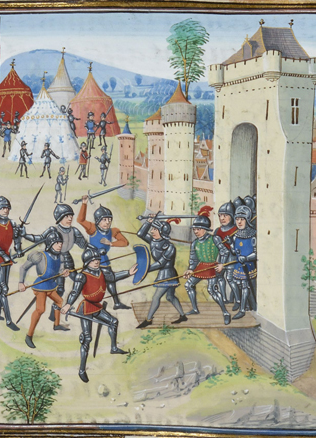The Gods Kernavė Citizens Prayed to in the 14th century
Tradition of Romanticism: sacred fire “kindled” …in the 19th century
According to the legends, after King Władysław II Jagiełło extinguished the sacred fire in Vilnius, the chief pagan priest Kriwe-Kriwajto moved to Kernavė to worship the old pagan Gods. The image of Kernavė, as the last citadel of Paganism in Lithuania, can often be found in the literary works written by representatives of the Romanticism Epoch.
Do You Know?
Kernavė hillforts were given the names of the Mount of Altar, Mindaugas’ Throne and Lizdeika by the romanticists of the 19th century.
It was in the 19th century that Kernavė hillforts acquired the names well known today, such as the Hill of the Altar (Aukuro kalno), Throne of Mindaugas (Mindaugo sostas), Lizdeika, etc.
During his journey along the Neris river, Count Konstanty Tyszkiewicz came up with the following vision of Kernavė hillforts: “On one of them, the sacred fire of the Eternal Flame Fireplace, worshipped by the indigenous people, was burning. On yet another mound, Kriwe-Kriwajto, the great pagan priest of the old Lithuania, was explaining the destiny or preaching the will of God to people around. On still another hillfort, Lithuania’s ruler and Lord, Grand Duke of Lithuania, was expressing his respect to the Eternal Flame Fireplace and sending orders to his subordinates in the country, showing his concern for the citizens’ rights and for maintaining public order in the country.” A similar idyllic picture of a strong political power and eternally blazing pagan altars is often visualized by the Kernavė visitors of today.
What we know about Kernavė
Notwithstanding the aforementioned insights, the results of archaeological research conducted in the hillforts, burial grounds of the historical period in question and farmsteads of Kernavė’s inhabitants reveal a slightly different picture.
The hillforts formed a strong defensive system.
The main hillfort, called the Mount of the Altar, accommodated the Duke’s castle, used as the Duke’s residence. It was protected by the hillforts of Mindaugas’ throne and Lizdeika, which served as powerful and enforced outwork, with the castle garrison established in them. Various crafts were thriving in the farmsteads situated on the hillfort of the Castle Hill. Their quarters accommodated by craftsmen spread along the Pajauta valley and to the North of the hillforts. Archaeologists have not yet discovered a sacred pagan site of Kernavė, even though there is little doubt, if any, about the existence of such a place in the capital of pagan Lithuania. Presumably, such a sacred site might have been located on the fifth hillfort of Kernavė, bearing the name of Žvalgakalnis. It was discovered merely some decades ago and has not yet undergone archaeological excavation. This hillfort is installed at some distance from the former capital, next to the burial site of that time. On the other hand, there were no Christian houses of worship in the Kernavė of the 14th century, such as Christian or Orthodox churches. The question arises what Gods were the Kernavė inhabitants praying to then? Where was their place of worship? The historical context of Kernavė and the data of archaeological research can help us answer these questions.
A beehive of nations and traditions
Such a centre of trade and crafts could hardly have existed without the contribution of foreigners. The Grand Duchy of Lithuania was mixed both in terms of nationality and religious confession. The development of Vilnius city in the 14th century was largely influenced by the expansion of new territories, which were inhabited by foreigners (both of Orthodox and Christian origin). Kernavė was no exception in this respect. Part of its community members did not speak Lithuanian and apparently professed Christian beliefs. This is testified by numerous pieces of jewellery made in the Slavic tradition and crosses, related to the Christian worldview, found in Kernavė. Two burial sites dating back to the 14th century have been excavated by archaeologists in Kernavė. In one of them, the dead were burned and then buried in water, whereas in the other the bodies of the deceased were buried in the ground unburnt, which was more acceptable to Christians. In the latter burial site, archaeologists unearthed a large amount of jewellery. In all likelihood, members of an ethnically mixed community were buried here. They could have been slaves labouring as craftsmen, having come from foreign countries to work for the Duke, merchants and their families. Part of the shroud found in the Kernavė burial site reminds of the ware, characteristic of Yotvingian burial monuments. The inventories of the Yotvingian burial site, identified in the upper reaches of the Nemunas, are practically identical to the findings of the Kernavė burial site. This is proof that the individuals of Yotvingian origin must have made a significant part of the Kernavė community. There is mention of the Yotvingians’ plight to Lithuania from Russians (in later times from Germans as well) is mentioned in historical sources.
Different burial traditions, the concept and views of an afterlife world – all this suggests that Kernavė was inhabited by an ethnically mixed community.
It is hard to tell which reasons determined different funeral rituals. It could have been the nationality of the deceased person or belonging to a certain religious community or social category. According to yet another hypothesis, the dead could have been burnt merely in the time of plague or war.
The absence of script suggests the prevalence of Lithuanians
There is no data about the part of the Kernavė population made by the foreign Christians.
This notwithstanding, the fact that there was no script in the daily life of the town proves the Lithuanian character of Kernavė.
On the level of the Duke’s Chancery, there is archaeological evidence that at least one literate scribe did visit the hillfort of the Altar Hill. During the visit, he lost his stylus, a means of writing at that time, there. 600 years later, the stylus was unearthed by archaeologists. In the other towns of GDL of those days (Navahrudak, Grodno, Vawkavysk), evidence of the Slavic script is quite frequently identified on various household items, pieces of ceramics, ivory and spindles. Plenty of styli have been discovered proving that a literate Slavic community was inhabiting those places. Kernavė is only 150 km away from the aforementioned towns, however, archaeological excavations of about 30 years have not revealed any similar findings. Quite likely, members of an ethnically mixed Kernavė community did not make a separate organizational unit, as was the case with the Russian part of the Vilnius city. There was no Orthodox church here, uniting the Slavic community of that time. Religious syncretism was a key feature of the Kernavė community in the 14th century.
Gintautas Vėlius


